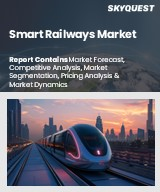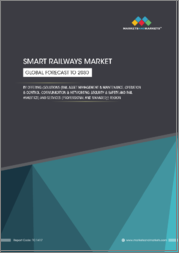
|
시장보고서
상품코드
1621670
스마트 Agri-레일 시스템 시장 기회, 성장 촉진요인, 산업 동향 분석, 예측(2024-2032년)Smart Agri-Rail System Market Opportunity, Growth Drivers, Industry Trend Analysis, and Forecast 2024 to 2032 |
||||||
세계의 스마트 Agri-레일 시스템 시장은 2023년에는 35억 달러로 평가되며, 2024-2032년 CAGR 9.2%로 확대할 것으로 예측됩니다.
이 같은 성장에는 세계 인구 증가와 식량안보에 대한 우려가 크게 작용하고 있습니다. 스마트 농업 철도 시스템은 특히 인구가 급증하는 지역과 식량 수입에 크게 의존하는 지역에서 식량 공급망을 강화하고 농업 생산성을 높이는 데 중요한 역할을 하고 있습니다. 농장이 점점 더 디지털화되고 데이터베이스 방식을 채택함에 따라 정교한 운송 솔루션에 대한 수요도 증가하고 있습니다. 블록체인 기술을 식품 공급망에 통합함으로써 스마트 농업 철도 시스템은 수확 일정과 물류 간의 조정을 개선할 수 있습니다.
시장은 철도 유형에 따라 화물철도, 복합운송철도, 고속철도로 분류되며, 2023년에는 화물철도가 시장을 장악하여 65% 이상의 점유율을 차지할 것으로 예상되며, 2032년에는 50억 달러 이상에 달할 것으로 전망됩니다. 현재 화물차에는 스마트 센서와 사물인터넷(IoT) 장비가 장착되어 농산물을 실시간으로 모니터링할 수 있습니다. 이러한 시스템은 온도, 습도, 에틸렌 수준과 같은 중요한 조건을 추적하여 신선식품의 최적 보존을 보장합니다. 고급 알고리즘은 다양한 제품의 특정 요구 사항에 따라 보관 조건을 조정하고 환기 및 냉각을 변경하여 농산물의 저장 수명을 향상시킵니다.
또한 이러한 기술은 실시간 화물 추적을 용이하게 하고, 이해관계자가 원격으로 배송을 모니터링하고 문제가 발생하면 신속하게 처리할 수 있도록 합니다. 농산물 하역을 위한 자동화 시스템은 화물 철도에 널리 보급되고 있습니다. 인공지능과 컴퓨터 비전으로 유도되는 로봇 암과 컨베이어 시스템은 다양한 유형의 화물을 정확하게 관리할 수 있습니다. 이러한 기술은 농산물의 유형에 따라 취급 기술을 조정하여 손상을 최소화하고 적재 시간을 단축할 수 있습니다.
| 시장 범위 | |
|---|---|
| 개시년 | 2023년 |
| 예측년 | 2024-2032년 |
| 개시 금액 | 35억 달러 |
| 예측 금액 | 75억 달러 |
| CAGR | 9.2% |
통합형 스마트 농업 철도 시스템은 무게 배분을 최적화하여 작업의 안전성과 효율성을 향상시킵니다. 자동화를 통해 프로세스 속도를 향상시키고 인건비를 절감하며 인적 오류 가능성을 줄여 보다 효율적인 농업 화물 작업을 실현할 수 있습니다. 스마트 농업 철도 시스템 시장은 하드웨어, 소프트웨어, 서비스 등 컴포넌트별로도 분류됩니다. 하드웨어 부문은 2032년까지 35억 달러를 넘어설 것으로 예상됩니다. 센서 기술의 혁신이 스마트 농업용 철도 시스템을 변화시키고 있습니다.
강력한 센서는 열악한 철도 조건을 견딜 수 있도록 설계되었으며, 궤도 상태를 나타내는 고정밀 진동 센서, 농지 토양 수분 센서, 작물 상태를 나타내는 다중 스펙트럼 센서 등이 포함됩니다. 미국 스마트 농업용 철도 시스템 시장은 2023년 매출의 85% 이상을 차지할 것으로 예상되며, 미국 기업이 철도 터미널에서 지역 유통업체까지 라스트 마일 배송을 위한 자율주행차 통합을 주도하고 있습니다. 실시간 수요와 교통량을 기반으로 배송 일정을 최적화하는 AI 기반 라우팅 시스템에 대한 투자가 진행 중이며, 인건비를 절감하고 배송 시간을 개선하는 동시에 농산물을 효율적으로 운송하는 복잡한 과제를 해결하고 있습니다.
목차
제1장 조사 방법과 조사 범위
제2장 개요
제3장 산업 인사이트
- 에코시스템 분석
- 공급업체 상황
- 농업 종사자와 농산물
- 물류 서비스 프로바이더
- 철도 사업자
- 기술 인티그레이터
- 최종사용자
- 이익률 분석
- 차별화 기술
- 실시간 추적
- 빅데이터 분석
- 자동 실음과 내림
- 온도 관리된 운송
- 기타
- 주요 뉴스와 구상
- 규제 상황
- 영향요인
- 촉진요인
- 식량 안전 보장에 대한 세계의 우려 증가
- 철도 인프라 투자의 증가
- 스마트 농업의 채택 증가
- 자동화 동향의 증가
- 산업의 잠재적 리스크·과제
- 기술 통합의 복잡성
- 데이터 관리와 표준화 문제
- 촉진요인
- 성장 가능성 분석
- Porter의 산업 분석
- PESTEL 분석
제4장 경쟁 구도
- 서론
- 기업 점유율 분석
- 경쟁 포지셔닝 매트릭스
- 전략 전망 매트릭스
제5장 시장 추정·예측 : 컴포넌트별, 2021-2032년
- 주요 동향
- 하드웨어
- 소프트웨어
- 서비스
- 전문 서비스
- 매니지드 서비스
제6장 시장 추정·예측 : 기술별, 2021-2032년
- 주요 동향
- IoT 센서
- GPS 트래킹
- 데이터 분석
- 자동화 시스템
- 기타
제7장 시장 추정·예측 : 용도별, 2021-2032년
- 주요 동향
- 농작물 운송
- 가축 운송
- 농업기계 운송
- 기타
제8장 시장 추정·예측 : 철도별, 2021-2032년
- 주요 동향
- 화물 철도
- 인터모달 운송 철도
- 고속 철도
제9장 시장 추정·예측 : 최종 용도별, 2021-2032년
- 주요 동향
- 농업 종사자와 농업 협동 조합
- 식품 가공 회사
- 소매업체와 유통업체
- 정부기관
제10장 시장 추정·예측 : 지역별, 2021-2032년
- 주요 동향
- 북미
- 미국
- 캐나다
- 유럽
- 영국
- 독일
- 프랑스
- 스페인
- 이탈리아
- 러시아
- 북유럽
- 아시아태평양
- 중국
- 인도
- 일본
- 한국
- 뉴질랜드
- 동남아시아
- 라틴아메리카
- 브라질
- 멕시코
- 아르헨티나
- 중동 및 아프리카
- 아랍에미리트
- 남아프리카공화국
- 사우디아라비아
제11장 기업 개요
- ABB
- AeoLogic
- Alstom
- Canadian National Railway
- Cisco
- CRRC Corporation
- DB Cargo
- Emerson
- Hitachi Rail
- Honeywell
- IBM
- Knorr-Bremse AG
- Nokia
- Bosch
- Rockwell Automation
- SAP
- Schneider Electric
- Siemens
- Toshiba
- Wabtec
- WSP Global
The Global Smart Agri-Rail System Market was valued at USD 3.5 billion in 2023 and is expected to expand at 9.2% CAGR from 2024 to 2032. This growth is largely driven by increasing global populations and heightened concerns regarding food security. Smart agri-rail systems play a crucial role in strengthening the food supply chain and enhancing agricultural productivity, especially in areas experiencing rapid population growth or relying heavily on food imports. As farms increasingly adopt digitized, data-driven practices, the demand for sophisticated transportation solutions also rises. By integrating blockchain technology into the food supply chain, smart agri-rail systems improve coordination between harvesting schedules and logistics.
The market is categorized by rail type into freight railways, intermodal rail transport, and high-speed rail. In 2023, freight railways dominated the market, capturing over 65% of the share and anticipated to exceed USD 5 billion by 2032. Freight cars are now equipped with smart sensors and Internet of Things (IoT) devices that provide real-time monitoring of agricultural cargo. These systems track critical conditions such as temperature, humidity, and ethylene levels to ensure the optimal preservation of perishable goods. Advanced algorithms adjust storage conditions according to the specific requirements of various products, enhancing the shelf life of produce by modifying ventilation and cooling.
Additionally, these technologies facilitate real-time cargo tracking, enabling stakeholders to monitor shipments remotely and promptly address any issues. Automated systems for loading and unloading agricultural products are becoming more prevalent in freight railways. Robotic arms and conveyor systems, guided by artificial intelligence and computer vision, manage diverse cargo types with accuracy. These technologies adjust handling techniques based on the type of produce, thereby minimizing damage and reducing loading times.
| Market Scope | |
|---|---|
| Start Year | 2023 |
| Forecast Year | 2024-2032 |
| Start Value | $3.5 Billion |
| Forecast Value | $7.5 Billion |
| CAGR | 9.2% |
Integrated smart weighing systems optimize weight distribution, improving safety and efficiency in operations. Automation enhances process speed, cuts labor costs, and reduces the potential for human error, resulting in more efficient agricultural freight operations. The smart agri-rail system market is also segmented by components, including hardware, software, and services. The hardware segment is projected to surpass USD 3.5 billion by 2032. Innovations in sensor technology are transforming smart agri-rail systems.
Robust sensors are designed to withstand harsh railway conditions, including high-precision vibration sensors for track health, soil moisture sensors for agricultural land, and multi-spectral sensors for crop health. The U.S. market for smart agri-rail systems constituted over 85% of revenue in 2023, with American companies leading the integration of autonomous vehicles for last-mile delivery from rail terminals to local distributors. Investments in AI-driven routing systems are underway to optimize delivery schedules based on real-time demand and traffic, addressing the complexities of efficiently transporting agricultural products while reducing labor costs and improving delivery times
Table of Contents
Chapter 1 Methodology & Scope
- 1.1 Research design
- 1.1.1 Research approach
- 1.1.2 Data collection methods
- 1.2 Base estimates and calculations
- 1.2.1 Base year calculation
- 1.2.2 Key trends for market estimates
- 1.3 Forecast model
- 1.4 Primary research & validation
- 1.4.1 Primary sources
- 1.4.2 Data mining sources
- 1.5 Market definitions
Chapter 2 Executive Summary
- 2.1 Industry 360° synopsis, 2021 - 2032
Chapter 3 Industry Insights
- 3.1 Industry ecosystem analysis
- 3.2 Supplier landscape
- 3.2.1 Farmers & agricultural produces
- 3.2.2 Logistics service providers
- 3.2.3 Railway operators
- 3.2.4 Technology integrators
- 3.2.5 End users
- 3.3 Profit margin analysis
- 3.4 Technology differentiators
- 3.4.1 Real-time tracking
- 3.4.2 Big data analytics
- 3.4.3 Automated loading/unloading
- 3.4.4 Temperature-controlled transport
- 3.4.5 Others
- 3.5 Key news & initiatives
- 3.6 Regulatory landscape
- 3.7 Impact forces
- 3.7.1 Growth drivers
- 3.7.1.1 Growing global concerns over food security
- 3.7.1.2 Rising rail infrastructure investments
- 3.7.1.3 Increasing adoption of smart farming practices
- 3.7.1.4 Rising automation trends
- 3.7.2 Industry pitfalls & challenges
- 3.7.2.1 Technology integration complexities
- 3.7.2.2 Data management & standardization issues
- 3.7.1 Growth drivers
- 3.8 Growth potential analysis
- 3.9 Porter's analysis
- 3.10 PESTEL analysis
Chapter 4 Competitive Landscape, 2023
- 4.1 Introduction
- 4.2 Company market share analysis
- 4.3 Competitive positioning matrix
- 4.4 Strategic outlook matrix
Chapter 5 Market Estimates & Forecast, By Component, 2021 - 2032 ($Bn)
- 5.1 Key trends
- 5.2 Hardware
- 5.3 Software
- 5.4 Services
- 5.4.1 Professional services
- 5.4.2 Managed services
Chapter 6 Market Estimates & Forecast, By Technology, 2021 - 2032 ($Bn)
- 6.1 Key trends
- 6.2 IoT sensors
- 6.3 GPS tracking
- 6.4 Data analytics
- 6.5 Automation systems
- 6.6 Others
Chapter 7 Market Estimates & Forecast, By Application, 2021 - 2032 ($Bn)
- 7.1 Key trends
- 7.2 Crop transportation
- 7.3 Livestock transportation
- 7.4 Agricultural machinery transportation
- 7.5 Others
Chapter 8 Market Estimates & Forecast, By Rail, 2021 - 2032 ($Bn)
- 8.1 Key trends
- 8.2 Freight railways
- 8.3 Intermodal rail transport
- 8.4 High-speed rail
Chapter 9 Market Estimates & Forecast, By End Use, 2021 - 2032 ($Bn)
- 9.1 Key trends
- 9.2 Farmers and agricultural cooperatives
- 9.3 Food processing companies
- 9.4 Retailers and distributors
- 9.5 Government agencies
Chapter 10 Market Estimates & Forecast, By Region, 2021 - 2032 ($Bn)
- 10.1 Key trends
- 10.2 North America
- 10.2.1 U.S.
- 10.2.2 Canada
- 10.3 Europe
- 10.3.1 UK
- 10.3.2 Germany
- 10.3.3 France
- 10.3.4 Spain
- 10.3.5 Italy
- 10.3.6 Russia
- 10.3.7 Nordics
- 10.4 Asia Pacific
- 10.4.1 China
- 10.4.2 India
- 10.4.3 Japan
- 10.4.4 South Korea
- 10.4.5 ANZ
- 10.4.6 Southeast Asia
- 10.5 Latin America
- 10.5.1 Brazil
- 10.5.2 Mexico
- 10.5.3 Argentina
- 10.6 MEA
- 10.6.1 UAE
- 10.6.2 South Africa
- 10.6.3 Saudi Arabia
Chapter 11 Company Profiles
- 11.1 ABB
- 11.2 AeoLogic
- 11.3 Alstom
- 11.4 Canadian National Railway
- 11.5 Cisco
- 11.6 CRRC Corporation
- 11.7 DB Cargo
- 11.8 Emerson
- 11.9 Hitachi Rail
- 11.10 Honeywell
- 11.11 IBM
- 11.12 Knorr-Bremse AG
- 11.13 Nokia
- 11.14 Bosch
- 11.15 Rockwell Automation
- 11.16 SAP
- 11.17 Schneider Electric
- 11.18 Siemens
- 11.19 Toshiba
- 11.20 Wabtec
- 11.21 WSP Global











